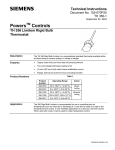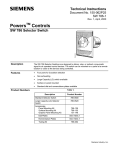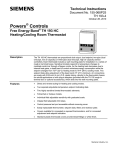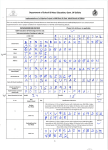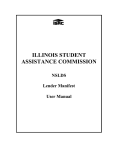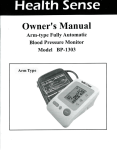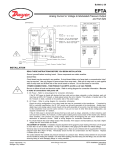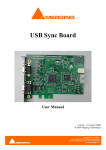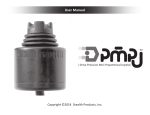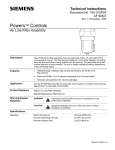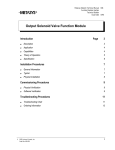Download Powers Controls
Transcript
Technical Instructions Document No. 155-124P25 RL 243-17 April 1, 2005 PowersTM Controls RL 243 Reverse Acting Relay Description The RL 243 Reverse Acting Pneumatic Relay provides a proportional output signal that varies inversely with the input signal. A spring adjustment is provided to allow setting a desired reverse acting schedule required by a particular application. Features • Lightweight and compact • Can be mounted in any position (mounting bracket and screws included) • Field adjustable spring range • Can be used as a signal inverting relay • Force-balance operation minimizes air consumption • lnternal relief provides fail-safe operation • Amplifies air volume to minimize system lag Product Number 243-0024 Reverse Acting Relay with mounting bracket, and two screws. Specifications Operating range Adjustment using 5/64-inch (2 mm) hex wrench Range adjustment Factory setting Material - housing Maximum ambient temperature Maximum air pressure Air capacity Air consumption for air compressor sizing Air connections Mounting Dimensions Shipping weight 0 to 30 psi (0 to 207 kPa) 10 to 30 psi (69 to 207 kPa) 15 psi (103 kPa) Glass-filled nylon 140°F (60°C) 30 psig (207 kPa) 230 scim (63 ml/s) 29 scim (8 ml/s) Barbed nipple for 1/4-inch (6 mm) OD polyethylene tubing Mounting bracket provided See Figures 5 and 6 0.27 lb (0.13 kg) Siemens Industry, Inc. Technical Instructions Document Number 155-124P25 April 1, 2005 RL 243 Reverse Acting Relay Warning/Caution Notations Application Signal Reversing WARNING Personal injury/loss of life may occur if you do not perform a procedure as specified. CAUTION Equipment damage, or loss of data may occur if you do not perform a procedure as specified. This relay has two applications. For both applications the supply air pressure must be equal to or greater than the spring setting. 1. The relay reverses a controller signal to match the operation of a control element. See Figure 1. OPERATIONAL FORMULA: B = SP – S1 SP = 15 psi Input S1 Output B 0 5 10 15 15 10 5 0 Legend B Output pressure S2 Not used M Supply air SP Spring setting S1 Input pressure Figure 1. Reverse Acting Relay Application. An increase in input pressure causes equivalent decrease in output pressure. Page 2 Siemens Industry, Inc. RL 243 Reverse Acting Relay Application, continued Technical Instructions Document Number 155-124P25 April 1, 2005 2. A typical application reverses the action of a face and by-pass damper actuator on a coil used for both heating and cooling. See Figure 2. OPERATIONAL FORMULA: Signal Inverting B = S1 if S1< 1/2 SP B = SP – S1 if S1> 1/2 SP SP = 15 psi Input S1 and M Output B 0 0 3 3 7.5 7.5 12 3 15 0 Legend B Output pressure S2 Not used M Input pressure SP Spring setting S1 Input pressure Figure 2. Signal lnverting Application. The output pressure is directly proportional to the input pressure until one half the spring setting is reached. After this point, the output pressure is inversely proportional to the input until the output reaches zero. Operation Reverse Acting See Figure 3 Supply air pressure is connected to the M port. The input signal is connected to the S1 port. The output signal is connected to the B port. The S2 port is not used. With no pressure at the S1 port, the adjusting spring pushes down on the stack. This causes the stack to contact the supply-exhaust valve assembly which first closes the exhaust port then opens the supply port. This allows supply air to flow into the B port chamber. When the pressure in the B port chamber is the same as the downward force on the stack, the stack will move up, causing the supply-exhaust valve assembly to close the supply port. Pressure at the S1 port causes an upward force on the stack that opposes the downward force caused by the adjusting spring. The stack moves up allowing the exhaust port to open, relieving the B port pressure. When the B port pressure plus S1 pressure equals the downward force of the adjusting spring, the stack will move down, closing the exhaust port. Siemens Industry, Inc. Page 3 Technical Instructions Document Number 155-124P25 April 1, 2005 RL 243 Reverse Acting Relay Operation, Continued See Figure 3 Figure 3. Relay Operation. Signal lnverting Connect the input signal to both M and S1 ports and connect the output signal to the B port. Port S2 is not used. With the spring set for 15 psi (103 kPa), the exhaust port is closed and the supply port is open to the B chamber until S1 pressure plus B pressure equals 15 psi (103 kPa). As S1 increases, the exhaust port opens, causing B to decrease to maintain the S1 + B = 15 psi (103 kPa) relationship. A small leak port between M and B chambers assures fast response and prevents the device from locking up on a loss of supply air pressure. Mounting and Installation Surface Mounting • Do not locate the device in areas with excessive vibration or corrosive atmosphere. • This device may be branch mounted or surface mounted. Mount the relay vertically or horizontally. • Install the relay so the port markings are visible and the spring adjustment screw is accessible. 1. Attach the provided bracket to the mounting surface with two #8 or #10 sheet metal screws (not provided). 2. Attach the relay to the bracket with the two 6-32 screws provided. The bracket has tapped holes for this purpose. Page 4 Siemens Industry, Inc. RL 243 Reverse Acting Relay Mounting and Installation, Continued Technical Instructions Document Number 155-124P25 April 1, 2005 3. Make all connections according to the piping diagram. 4. When disconnecting the tubing, use caution to avoid damaging the barbed nipples of the relay. The installation is now complete. CAUTION: Air supply must be clean, dry, and oil-free. Adjustment The relay has an adjustment spring that allows the output range to be increased or decreased. 1. lnsert one gauge in the input line and another gauge in the output line. Use accurate gauges when adjusting the relay. 2. lnsert a 5/64-inch (2 mm) hex Allen wrench to adjust the spring, as shown in Figure 4. 3. Provide the desired maximum pressure to the input line. 4. Rotate the adjustment screw until the output pressure reads the lowest desired outlet pressure. Figure 4. Adjusting the Spring. Reverse Acting The spring can be adjusted to provide any range from 0 to 10 psi (0 to 69 kPa) to 0 to 30 psi (0 to 207 kPa). The air supply must be equal to or greater than the highest pressure in the range. Signal lnverting The spring can be adjusted for 10 to 30 psi (69 to 207 kPa) resulting in a maximum output pressure of 5 to 15 psi (34 to 103 kPa) respectively. Adjust spring for twice the maximum output pressure desired. ln Figure 2, the spring is set for 15 psi (103 kPa); therefore, the maximum output pressure is 7.5 psi (51 kPa). Service Siemens Industry, Inc. Do not attempt to disassemble the relay. If the relay is inoperative, replace it. Page 5 Technical Instructions Document Number 155-124P25 April 1, 2005 RL 243 Reverse Acting Relay Dimensions Figure 5. Relay Dimensions. Figure 6. Mounting Bracket Dimensions. Information in this publication is based on current specifications. The company reserves the right to make changes in specifications and models as design improvements are introduced. Powers is a registered trademark of Siemens Industry, Inc. Product or company names mentioned herein may be the trademarks of their respective owners. © 2005 Siemens Industry, Inc. Siemens Industry, Inc. Building Technologies Division 1000 Deerfield Parkway Buffalo Grove, IL 60089 + 1 847-215-1000 Your feedback is important to us. If you have comments about this document, please send them to [email protected] Document No. 155-124P25 Printed in the USA Page 6






